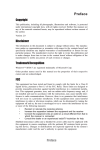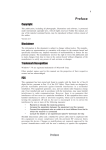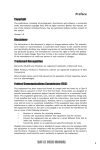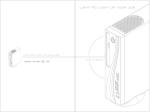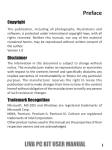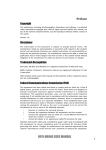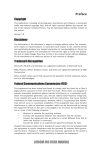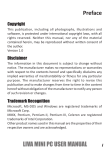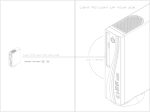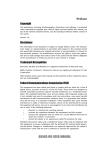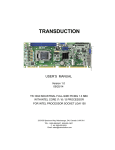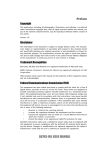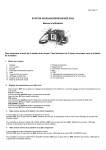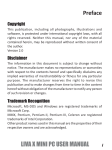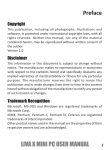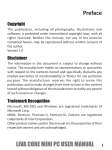Download chapter 1.pmd
Transcript
i Preface Copyright This publication, including all photographs, illustrations and software, is protected under international copyright laws, with all rights reserved. Neither this manual, nor any of the material contained herein, may be reproduced without written consent of the author. Version 1.0 Disclaimer The information in this document is subject to change without notice. The manufacturer makes no representations or warranties with respect to the contents hereof and specifically disclaims any implied warranties of merchantability or fitness for any particular purpose. The manufacturer reserves the right to revise this publication and to make changes from time to time in the content hereof without obligation of the manufacturer to notify any person of such revision or changes. Trademark Recognition Windows® 7/8 are registered trademarks of Microsoft Corp. Other product names used in this manual are the properties of their respective owners and are acknowledged. FCC This equipment has been tested and found to comply with the limits for a Class B digital device, pursuant to Part 15 of the FCC Rules. These limits are designed to provide reasonable protection against harmful interference in a residential installation. This equipment generates, uses, and can radiate radio frequency energy and, if not installed and used in accordance with the instructions, may cause harmful interference to radio communications. However, there is no guarantee that interference will not occur in a particular installation. If this equipment does cause harmful interference to radio or television reception, which can be determined by turning the equipment off and on, the user is encouraged to try to correct the interference by one or more of the following measures: • • • • Reorient or relocate the receiving antenna Increase the separation between the equipment and the receiver Connect the equipment onto an outlet on a circuit different from that to which the receiver is connected Consult the dealer or an experienced radio/TV technician for help Shielded interconnect cables and a shielded AC power cable must be employed with this equipment to ensure compliance with the pertinent RF emission limits governing this device. Changes or modifications not expressly approved by the system’s manufacturer could void the user’s authority to operate the equipment. Preface ii Declaration of Conformity This device complies with part 15 of the FCC rules. Operation is subject to the following conditions: • • This device may not cause harmful interference, and This device must accept any interference received, including interference that may cause undesired operation CE This product has been tested and found to comply with the limits of the European Council Directive on the approximation of the laws of the member states relating to electromagnetic compatibility according to 2004/108/EC. Canadian Department of Communications This class B digital apparatus meets all requirements of the Canadian Interferencecausing Equipment Regulations. Cet appareil numérique de la classe B respecte toutes les exigences du Réglement sur le matériel brouilieur du Canada. Preface iii Safety Instructions Your system is designed and tested to meet the latest standards of safety for information technology equipment. However, to ensure your safety, it is important that you read the following safety instructions. Setting up your system • • • • • • Read and follow all instructions in the documentation before you operate your system. Do not use this product near water or a heated source such as a radiator. Set up the system on a stable surface. Openings on the chassis are for ventilation. Do not block or cover these openings. Make sure you leave plenty of space around the system for ventilation. Never insert objects of any kind into the ventilation openings. Use this product in environments with ambient temperatures between 0°C and 40°C. If you use an extension cord, make sure that the total ampere rating of the devices plugged into the extension cord does not exceed its ampere rating. Attention during use • • • • Do not step on the power cord or let anything rest on top of it. Do not spill water or any other liquid on your system. When the system is turned OFF, a small amount of electrical currentstill flows. Always unplug all power, modem, and network cables from the power outlets before cleaning the system. If you encounter the following technical problems with the product, unplug the power cord and contact a qualified service technician or your retailer. • • • • • The power cord or plug is damaged. Liquid has been spilled into the system. The system does not function properly even if you follow the operating instructions. The system was dropped or the cabinet is damaged. The system performance changes The warranty does not apply to products that have been disassembled by users. Preface iv Safety cautions and warnings Optical Drive Safety Information Optical drive sold with this system contains a CLASS 1 LASER PRODUCT. CAUTION: Invisible laser radiation when open. Do not stare into beam or view directly with optical instructions. WARNING: Makeing adjustments or performing procedures other than those specified in the user’s manual may result in hazardous laser exposuer. Do not attempt to disassemble the optical drive. For your safety, have the optical drive serviced only by an authorized service provider. Product disposal notice INPORTANT: This symbol if the crossed out wheeled bin indicates that the product (electrical and electronic equipment) should not be placed in municipal waste. Check local regulations for disposal of electronic products. Nordic Lithium Cautions (for lithium-ion batteries) CAUTION: Danger of explosoin if battery is incorrectly replace only with the same or equivalent type recommended by the manufacturer. Dispose of used batteries according to the manufacturer’s instructions. Product disposal notice 1. Do not place this product underneath heavy loads or in an unstable position. 2. Do not use or expose this product around magnetic fields as magnetic interference may affect the performance of the product. 3. Do not expose this product to high levels of direct sunlight, high-humidity or wet conditions. 4. Do not block the air vents to this product or impede the airflow in any way. Preface v TABLE OF CONTENTS Preface i Chapter 1 1 Introducing the PC 1 Introduction......................................................................................1 1.1 Specfications...............................................................................1 1.2 Front view....................................................................................2 1.3 Left view of the computer..........................................................3 1.4 Back view.....................................................................................5 1.5 Connecting your computer.......................................................7 Packing Contents.............................................................................8 Chapter 2 9 Installing the System 9 2.1 Safety Precautions........................ ............................................ 9 2.2 Open the Chassis...................... ........................................... 9 2.3 Install the Key Components........................ ............................11 2.3.1 Installing Memory Modules............................................11 2.3.2 Installing Add-on Cards..................................................12 2.3.3 Installing a Hard Disk Drive..........................................13 2.3.4 Installing the Heatpipe...................................................14 2.4 Install the VESA Mount........................ ...................................15 2.5 Motherboard Components..................................................16 2.6 Checking Jumper Settings........................ ...................................18 2.7 Connecting Devices........................ ..........................................20 Chapter 3 27 Using BIOS 27 About the Setup Utility........................ ......................................... 27 The Standard Configuration........................ ............................27 Entering the Setup Utility.........................................................27 Resetting the Default CMOS Values........................................28 Using BIOS......................................................................................28 BIOS Navigation Keys............................................................29 Main Menu..............................................................................30 Advanced Menu.......................................................................31 Chipset Menu............................................................................40 Tweak Menu.............................................................................43 vi Boot Menu...............................................................................46 Security Menu.........................................................................47 Exit Menu................................................................................48 Updating the BIOS...................................................................49 Chapter 4 51 Using the Motherboard Software 51 Auto-installing under Windows 8................................................51 Running Setup...........................................................................51 Manual Installation.............................................................................53 Chapter 5 55 Trouble Shooting 55 Start up problems during assembly............................................55 Solving Problems.........................................................................55 Display Problems............................................................................55 Troubleshooting Audio Problems...................................................56 Maintenance and care tips.................................................................57 Panel clean tips.............................................................................57 1 Chapter 1 Introducing the PC Introduction Thank you for choosing AIO PC, which has great performance with stylish and power saving design, which will surely give you an exciting PC experience. 1.1 Specifications Display Panel • • 19.5” LED backlight LCD 16:9, 1600 x 900, Option: Capacitive 10-finger multi-touch Chipset • Intel® H81 Processor • Intel® 4 th-new & 4th Gen CoreTM Processor LGA 1150 Socket (Support CPU TDP up to 65W) Memory • • Support 2 x DDR3 1600 SO-DIMM, up to 16GB Support 1 x mSATA Storage • Support 1 x 2.5’’ SATA III HDD Wireless • Support IEEE 802.11b/g/n. and Bluetooth 4.0 (Optional) Power Supply • Adapter 19v, 120W VESA • 75mm x 75mm I/O (Side) • • • • 2 1 1 1 x USB 3.0 x Mic-in x Headphone x 3-in-1 Card Reader (SD/MMC/MS) I/O (Rear) • • • • • 3 1 1 1 1 x USB 2.0 x HDMI out x DC-IN port x Giga LAN x COM port (optional) Dimension • 484(W) x 335(H) x 38(D) mm Introducing the PC 2 1.2 Fron t view Note: ID design may vary. Webcam/Webcam LED Light The built-in webcam with the microphone can be used for picture taking, video recording, online conference and any other interactive applications. Webcam LED light is on when webcam is activated. Built-in Microphone The built-in microphone can be used for online video chatting. LCD/LED Display The 19.5-inch TFT LCD/LED display is with an optimal resolution of 1600X 900. Speakers The built-in stereo speakers deliver high quality sound blaster with stereo system and Hi-Fi function supported. Power LED Light The Power LED light indicates the different stage of system mode. When booting the system, Power LED light is steady on, and it will always be on during user operating the system. And when system is in sleep mode (S3), Power LED light is blinking. And when system is in hibernating mode (S4) and power off mode, Power LED light is off. WARNING: Do not thrust the speaker with your fingers or sharp-pointed things such as pens. Introducing the PC 3 1.3 Left view of the computer 1. Power Button 2. Brightness/Volume Up 3. Brightness/Volume Down 4. USB 3.0 Ports 5. Multi Card Reader 6. Headphone Jack 7. Microphone Jack 1.Power Button Press the power button to turn the system on and off. The power LED is on when you turn on the system; the power LED is off when you turn off the system. 2.Brightness/Volume Up* Press this button to turn up the brightness of screen or turn up the volume. 3.Brightness/Volume Down* Press this button to turn down the brightness of screen or turn down the volume. Note: *1.If you press the Brightness/Volume Up/Down button for less than 3s, the volume will be up/down for a step; and if you press the Brightness/Volume Up/Down button for more than 3s, the screen brightness will be up/down for a step. 2.If you press the Brightness/Volume Up/Down button for more than 3s, it switches into brightness adjustment mode which will last for nearly 30s, and if you press it for less than 3s, the mode will not be switched. After more than 30s idle, if you press it for less than 3s, it switches back to volume adjustment mode. Introducing the PC 4 4.USB 3.0 Ports The USB (Universal Serial Bus) 3.0 ports are provided for attaching USB 3.0 devices such as mouse, keyboard, printer, scanner, camera, PDA or other USB 3.0 compatible devices. 5.Multi Card Reader The build-in card reader may support various types of memory card, such as SD (Secure Digital), MS (Memory Stick) or MMC (Multi-Media Card) cards that usually used in devices like digital cameras, MP3 players, mobile phones and PDAs. Contact the local dealer for further information and please be noted that the supported memory cards may vary without notice. 6.Headphone Jack (Green) This is a jack for headphone. 7.Microphone Jack (Pink) This is a jack for microphone. Introducing the PC 5 1.4 Back view Computer stand Use the stand to position the display to your preference. The tilt down degree of monitor can be adjusted from 12o to 30o to meet all kinds of working environments. You can slightly push the computer backwards to increase the tilt down degree, otherwise, you can slightly pull the computer to decrease the tilt down degree. Please refer to the following pictures. The stand provides stability to the computer, please remain installed all the time to ensure maximum system stability. 12o min. 30o max. Introducing the PC 6 Rear I/O There are many ports below of the main chassis, such as USB ports, DC-in jack and LAN connector. Please refer to the specification on Page 1. You will find the I/O position as below. Note: The descriptions in this part might vary from your computer, depending on motherboard model and configurations. Introducing the PC 7 1.5 Connecting your computer Use the following information to connect your computer: Look for the small connector icons on the back of your computer. Match the connectors to the icons. Note: Your computer might not have all of the connectors that are described in this section. It mainly depend the motherboard you choose. 1. Check the voltage rating before you connect the equipment to an electrical outlet to ensure that the required voltage and frequency match the available power source. Note: After you connect the AC/DC Adapter and the AC Power Core, please connect the AC/DC Adapter to the DC-IN power connector in the Inside I/O port of the computer first, then connect the AC Power Cord to the power. 2. Connect the R45J LAN cable to the LAN port. 3. Your computer is equipped with a Memory Card Reader Connector, it is able to read/write data from: SD/MMC/MS. Introducing the PC 8 Packing Contents Driver DVD Adapter Manual Power Cable NOTE: Please contact us immediately if any of the items is damaged or missing. Introducing the PC 9 Chapter 2 Installing the System 2.1 Safety Precautions Follow these safety precautions when installing the system: • • • • Wear a grounding strap attached to a grounded device to avoid damage from static electricity. Discharge static electricity by touching the metal case of a safely grounded object before working on the motherboard. Leave components in the static-proof bags. Always remove the AC power by unplugging the power cord from the power outlet before installing. 2.2 Open the Chassis Please refer to the following pictures to open the chassis. Step 1. Loosen the four screws on bottom side of chassis. Step 2. Pull open the middle part of the chassis. Installing the System 10 Step 3. Follow the gesture as picture showed to unlock the hooks of left side. Step 4. Follow the gesture as picture showed to unlock the hooks of right side. Step 5. After unlock the hooks, hold the stand to lift up the back cover and open the chassis. Installing the System 11 2.3 Install the Key Components 2.3.1. Installing Memory Modules Do not remove any memory module from its antistatic packaging until you are ready to install it on the motherboard. Handle the modules only by their edges. Do not touch the components or metal parts. Always wear a grounding strap when you handle the modules. You must install one module in the slot. And one slot maximum supports 8 GB, total memory capacity of the two slots is 16 GB. Refer to the following to install the memory modules. Install the memory module into the slot and press it firmly down until it fits in place. Check that the cutouts on the memory module edge connector match the notches in the memory slot. Installing the System 12 2.3.2. Installing Add-on Cards The slots on this motherboard, which support wifi card and mSATA card, are designed to enhancing the system’s features and capabilities. With these efficient facilities, you can experience a convenient wireless environment and a high operation speed increase the capabilities by adding hardware that performs tasks that are not part of the basic system. The slot 1 (half card size) goes with PCIe and USB signal is reserved for wifi card. The slot 2 (full card size) goes with PCIe/USB/SATA signal, which can be used for mSATA SSD card. Follow these instructions to install a wifi card and mSATA card: 1. Insert a wifi card or mSATA card into the slot. 2. Lower the handle and tighten the screws. Installing the System 13 2.3.3. Installing a Hard Disk Drive This AIO PC features one SATA connector supporting one 2.5’’ hard disk drive. Loosen three screws to get the Hard disk cage off. Fix the Hard disk by four screws on the side. Assemble the Hard disk cage back to the chassis and connect to the SATA cable. Installing the System 14 2.3.4. Installing the Heatpipe Fix the Heatpipe by the five screws in numerical order. Installing the System 15 2.4 Install the VESA Mount This AIO PC supports standard 75 x 75mm VESA mount, and just need to remove the four rubbers of the back cover. Installing the System 16 2.5 Motherboard Components Installing the System 17 Table of Motherboard Components LABEL 1. CPU Socket 2. ME_UNLOCK 3. CLR_CMOS 4. DC_IN 5. HDMI 6. USB2 0_1~3 7. BT 8. LAN 9. MONO_OUT1 10. COM 11. FRONT_LED 12. MIC 13. HPOUT 14. CARD_READER 15. F_USB3 0_1~2 16. DDR3_1~2 17. SWITCH1~2 18. PWR_SW 19. MINI_PCIE 20. MSATA 21. LVDS1 22. CCD_DMIC 23. LVDSPW_CONN1 24. TOUCH_PANEL 25. HDD 26. LDC 27. CPU_FAN 28. SYS_FAN 29. HDD_PWR COMPONENTS Intel® 4th-new & 4th Gen Core Processor LGA 1150 Socket ME Unlock header with jumper Clear CMOS header with jumper DC in connector HDMI connector USB 2.0 connectors Battery connector LAN connector Internal Speakers Header Onboard serial port header Power LED header Microphone connector Headphone out connector Card reader slot Front panel USB 3.0 ports 204-pin DDR3 SDRAM slots Brightness/Volume Up/Down buttons Power on/off button Mini card slot Mini card slot LVDS connector Webcam header LVDS power header Touch panel connector SATA II connector Debug card header CPU cooling fan connector System cooling fan connector HDD power connector Installing the System 18 2.6 Checking Jumper Settings This section explains how to set jumpers for correct configuration of the motherboard. Setting Jumpers Use the motherboard jumpers to set system configuration options. Jumpers with more than one pin are numbered. When setting the jumpers, ensure that the jumper caps are placed on the correct pins. The illustrations show a 2-pin jumper. When the jumper cap is placed on both pins, the jumper is SHORT. If you remove the jumper cap, or place the jumper cap on just one pin, the jumper is OPEN. SHORT OPEN This illustration shows a 3-pin jumper. Pins 1 and 2 are SHORT. Checking Jumper Settings The following illustration shows the location of the motherboard jumpers. Pin 1 is labeled. No. Components 1 ME_UNLOCK 2 CLR_CMOS Installing the System 19 1. ME_UNLOCK: ME Unlock Header With Jumper 2. CLR_CMOS: Clear CMOS Header With Jumper The following illustration shows the location of the motherboard jumpers. Pin 1 is labeled. To avoid the system unstability after clearing CMOS, we recommend users to enter the main BIOS setting page to “Load Default Settings” and then “Save and Exit Setup”. Installing the System 20 2.7 Connecting Devices No. Components No. Components 1 LVDS1 7 CPU_FAN 2 CCD_DMIC 8 SYS_FAN 3 LVDSPW_CONN1 9 HDD_PWR 4 TOUCH_PANEL 10 BT 5 HDD 11 MONO_OUT1 6 LDC 12 FRONT_LED Installing the System 21 1. LVDS1: LVDS Connector 1. You can connect the large end of the cable to the LED Panel, and connect the other small end to the slot on the motherboard. 2.Due to the chipset limitation, using dual displays LVDS(AIO) + VGA or LVDS(AIO) + HDMI will cause the problem that you may not enter BIOS setup or have the display problem. Installing the System 22 2. CCD_DMIC: Webcam Header 3. LVDSPW_CONN1: LVDS Power Header Installing the System 23 4. TOUCH_PANEL: Touch Panel Connector 5. HDD: SATA II Connector Installing the System 24 6. LDC: Debug Card Header 7 & 8. CPU_FAN: CPU Cooling FAN Connector & SYS_FAN: System Cooling FAN Connector Installing the System 25 9. HDD_PWR: HDD Power Connector 10. BT: Battery Connector Installing the System 26 11. MONO_OUT1: Internal Speakers Header 12. FRONT_LED: Power LED Header Installing the System 27 Chapter 3 Using BIOS About the Setup Utility The computer uses the latest “American Megatrends Inc. ” BIOS with support for Windows Plug and Play. The CMOS chip on the motherboard contains the ROM setup instructions for configuring the motherboard BIOS. The BIOS (Basic Input and Output System) Setup Utility displays the system’s configuration status and provides you with options to set system parameters. The parameters are stored in battery-backed-up CMOS RAM that saves this information when the power is turned off. When the system is turned back on, the system is configured with the values you stored in CMOS. The BIOS Setup Utility enables you to configure: • Hard drives, diskette drives and peripherals • Video display type and display options • Password protection from unauthorized use • Power Management features The settings made in the Setup Utility affect how the computer performs. Before using the Setup Utility, ensure that you understand the Setup Utility options. This chapter provides explanations for Setup Utility options. The Standard Configuration A standard configuration has already been set in the Setup Utility. However, we recommend that you read this chapter in case you need to make any changes in the future. This Setup Utility should be used: • when changing the system configuration • when a configuration error is detected and you are prompted to make changes to the Setup Utility • when trying to resolve IRQ conflicts • when making changes to the Power Management configuration • when changing the password or making other changes to the Security Setup Entering the Setup Utility When you power on the system, BIOS enters the Power-On Self Test (POST) routines. POST is a series of built-in diagnostics performed by the BIOS. After the POST routines are completed, the following message appears: Press DEL to enter SETUP Using BIOS 28 Press the delete key to access BIOS Setup Utility. Aptio Setup Utility - Copyright (C) 2012 American Megatrends, Inc. Main Advanced Chipset Tweak Boot Security Exit Choose the system default language BIOS Information System Language [English] System Date System Time [Wed 08/27/2014] [02:03:19] lk:Select Screen mn :Select Item Enter : Select +/- :Change Opt. F1:General Help F2:Previous Values F3:Optimized Defaults F4:Save & Exit ESC:Exit Version 2.15.1236. Copyright (C) 2012 American Megatrends, Inc. Resetting the Default CMOS Values When powering on for the first time, the POST screen may show a “CMOS Settings Wrong” message. This standard message will appear following a clear CMOS data at factory by the manufacturer. You simply need to Load Default Settings to reset the default CMOS values. Note: Changes to system hardware such as different CPU, memories, etc. may also trigger this message. Using BIOS When you start the Setup Utility, the main menu appears. The main menu of the Setup Utility displays a list of the options that are available. A highlight indicates which option is currently selected. Use the cursor arrow keys to move the highlight to other options. When an option is highlighted, execute the option by pressing <Enter>. Some options lead to pop-up dialog boxes that prompt you to verify that you wish to execute that option. Other options lead to dialog boxes that prompt you for information. Some options (marked with a trianglef) lead to submenus that enable you to change the values for the option. Use the cursor arrow keys to scroll through the items in the submenu. Using BIOS 29 In this manual, default values are enclosed in parenthesis. Submenu items are denoted by a triangle f. The default BIOS setting for this motherboard apply for most conditions with optimum performance. We do not suggest users change the default values in the BIOS setup and take no responsibility to any damage caused by changing the BIOS settings. BIOS Navigation Keys The BIOS navigation keys are listed below: KEY ESC FUNCTION Exits the current menu mnlk Scrolls through the items on a menu +/Enter Modifies the selected field’s values Select F1 General Help F2 Previous Values F3 Optimized Defaults F4 Save & Exit For the purpose of better product maintenance, the manufacture reserves the right to change the BIOS items presented in this manual. The BIOS setup screens shown in this chapter are for reference only and may differ from the actual BIOS. Please visit the manufacture’s website for updated manual. Using BIOS 30 Main Menu When you enter the BIOS Setup program, the main menu appears, giving you an overview of the basic system information. Select an item and press <Enter> to display the submenu. Aptio Setup Utility - Copyright (C) 2012 American Megatrends, Inc. Main Advanced Chipset Tweak Boot Security Exit Choose the system default language BIOS Information System Language [English] System Date System Time [Wed 08/27/2014] [02:03:19] lk:Select Screen mn :Select Item Enter : Select +/- :Change Opt. F1:General Help F2:Previous Values F3:Optimized Defaults F4:Save & Exit ESC:Exit Version 2.15.1236. Copyright (C) 2012 American Megatrends, Inc. System Language (English) This item is used to set the language. System Date & Time The Date and Time items show the current date and time on the computer. If you are running a Windows OS, these items are automatically updated whenever you make changes to the Windows Date and Time Properties utility. Using BIOS 31 Advanced Menu The Advanced menu items allow you to change the settings for the CPU and other system. Aptio Setup Utility - Copyright (C) 2012 American Megatrends, Inc. Main Advanced Chipset Tweak Boot Security Exit f LAN Configuration f PC Health Status f Power Management Setup f ACPI Settings f CPU Configuration f SATA Configuration f USB Configuration f Super IO Configuration LAN Configuration Parameters lk:Select Screen mn :Select Item Enter : Select +/- : Change Opt. F1:General Help F2:Previous Values F3:Optimized Defaults F4:Save & Exit ESC:Exit Version 2.15.1236. Copyright (C) 2012 American Megatrends, Inc. fLAN Configuration The item in the menu shows the LAN-related information that the BIOS automatically detects. Aptio Setup Utility - Copyright (C) 2012 American Megatrends, Inc. Main Advanced Chipset Tweak Boot Security Exit Enabled/Disabled Onboard LAN Controller LAN Configuration Onboard LAN Controller [Enabled] lk:Select Screen mn :Select Item Enter : Select +/- : Change Opt. F1:General Help F2:Previous Values F3:Optimized Defaults F4:Save & Exit ESC:Exit Version 2.15.1236. Copyright (C) 2012 American Megatrends, Inc. Onboard LAN Controller (Enabled) Use this item to enable or disable the Onboard LAN. Press <Esc> to return to the Advanced Menu page. Using BIOS 32 fPC Health Status On motherboards support hardware monitoring, this item lets you monitor the paremeters for critical voltages, temperatures and fan speeds. Aptio Setup Utility - Copyright (C) 2012 American Megatrends, Inc. Main Advanced Chipset Tweak Boot Security Exit PC Health Status CPU Temperature (DTS) CPU Fan Speed System Fan Speed CPU Voltage DIMM Voltage +12V +5V 53 0 RPM 1090 RPM 1.209V 1.122V 11.952V 4.987V TCC Activation Temperature (DTS) 100 lk:Select Screen mn :Select Item Enter : Select +/- : Change Opt. F1:General Help -=- PECI Mode -=F2:Previous Values Offset to TCC Activation Temp : -27 F3:Optimized Defaults F4:Save & Exit ESC:Exit Version 2.15.1236. Copyright (C) 2012 American Megatrends, Inc. System Component Characteristics These items display the monitoring of the overall inboard hardware health events, such as System & CPU temperature, CPU & DIMM voltage, CPU & system fan speed,... etc. • • • • • • • CPU Temperature (DTS) CPU Fan Speed System Fan Speed CPU Voltage DIMM Voltage +12V +5V Press <Esc> to return to the Advanced Menu page. Using BIOS 33 fPower Management Setup This page sets up some parameters for system power management operation. Aptio Setup Utility - Copyright (C) 2012 American Megatrends, Inc. Main Advanced Chipset Tweak Boot Security Exit Power Management Setup Resume By RING Resume By PME Resume By USB Resume By RTC Alarm EUP Function About Resume By Ring [Disabled] [Disabled] [Disabled] [Disabled] [Enabled] lk:Select Screen mn :Select Item Enter : Select +/- : Change Opt. F1:General Help F2:Previous Values F3:Optimized Defaults F4:Save & Exit ESC:Exit Version 2.15.1236. Copyright (C) 2012 American Megatrends, Inc. Resume By Ring (Disabled) An input signal on the serial Ring Indicator (RI) line (in other words, an incoming call on the modem) awakens the system from a soft off state. Resume By PME (Disabled) The system can be turned off with a software command. If you enable this item, the system can automatically resume if there is an incoming call on the PCI/PCI-E Modem or PCI/PCI-E LAN card. You must use an ATX power supply in order to use this feature. Use this item to do wake-up action if inserting the PCI/PCI-E card. Resume By USB (Disabled) This item allows you to enable or disable the USB device wakeup function from S3 mode. Resume By RTC Alarm (Disabled) The system can be turned off with a software command. If you enable this item, the system can automatically resume at a fixed time based on the system’s RTC (realtime clock). Use the items below this one to set the date and time of the wakeup alarm. You must use an ATX power supply in order to use this feature. EUP Function (Enabled) This item allows user to enable or disable EUP support. Press <Esc> to return to the Advanced Menu page. Using BIOS 34 f ACPI Settings The item in the menu shows the highest ACPI sleep state when the system enters suspend. Aptio Setup Utility - Copyright (C) 2012 American Megatrends, Inc. Main Advanced Chipset Tweak Boot Security Exit ACPI Settings ACPI Sleep State [S3 (Suspend to RAM)] Select the highest ACPI sleep state the system will enter when the SUSPEND button is pressed. lk:Select Screen mn :Select Item Enter : Select +/- : Change Opt. F1:General Help F2:Previous Values F3:Optimized Defaults F4:Save & Exit ESC:Exit Version 2.15.1236. Copyright (C) 2012 American Megatrends, Inc. ACPI Sleep State (S3(Suspend to RAM)) This item allows user to enter the ACPI S3 (Suspend toRAM) Sleep State(default). Press <Esc> to return to the Advanced Menu page. Using BIOS 35 fCPU Configuration The item in the menu shows the CPU information. Aptio Setup Utility - Copyright (C) 2012 American Megatrends, Inc. Main Advanced Chipset Tweak Boot Security Exit CPU Configuration Genuine Intel(R) CPU 0000 @ 2.00GHz EM64T Processor Speed Processor Stepping Microcode Revision Processor Cores Intel HT Technology Intel VT-x Technology Supported 2000 MHz 306c2 ffff0006 4 Supported Supported Hyper-threading Active Processor Cores Limit CPUID Maximum Execute Disable Bit Intel Virtualization Technology LakeTiny Feature CPU C3 Report CPU C6 Report CPU C7 Report Package C State limit Enhanced Halt (C1E) [Enabled] [All] [Disabled] [Enabled] [Enabled] [Enabled] [Enabled] [Disabled] [Disabled] [Auto] [Enabled] Enabled for Windows XP and Linux (OS optimized for Hyper-Threading Technology) and Disabled for other OS (OS not optimized for Hyper-Threading Technology). When Disabled only one thread per enabled core is enabled. lk:Select Screen mn :Select Item Enter : Select +/- : Change Opt. F1:General Help F2:Previous Values F3:Optimized Defaults F4:Save & Exit ESC:Exit Version 2.15.1236. Copyright (C) 2012 American Megatrends, Inc. Genuine Intel(R) CPU 0000 @ 2.00GHz This is display-only field and displays the information of the CPU installed in your computer. EM64T (Supported) This item shows the computer supports EM64T. Processor Speed (2000 MHz) This item shows the current processor speed. Processor Stepping (306c2) This item shows the processor stepping version. Microcode Revision (ffff0006) This item shows the Microcode version. Processor Cores (4) This item shows the core number of the processor. Intel HT Technology (Supported) This item shows the computer supports Intel HT technology or not. Intel VT-X Technology (Supported) This item shows the computer supports Intel VT-X technology or not. Hyper-Threading (Enabled) This item only available when the chipset supports Hyper-threading and you are using a Hyper-threading CPU. Active Processor Cores (All) Use this item to control the number of active processor cores. Using BIOS 36 Limit CPUID Maximum (Disabled) Use this item to enable or disable the maximum CPUID value limit, you can enable this to prevent the system from “rebooting” when trying to install Windows NT 4.0. Excute Disable Bit (Enabled) This item allows the processor to classify areas in memory by where application code can execute and where it cannot. When a malicious worm attempts to insert code in the buffer, the processor disables code execution, preventing damage or worm propagation. Replacing older computers with Execute Disable Bit enabled systems can halt worm attacks, reducing the need for virus related repair. Intel Virtualization Technology (Enabled) When enabled, a VMM can utilize the additional hardware capabilities provided by Vandor Pool Technology. LakeTiny Feature (Enabled) Use this item to enable or disable the LakeTiny for C state configuration. CPU C3 Report (Enabled) Use this item to enable or disable CPU C3 (ACPI C2) report to OS. CPU C6 Report (Disabled) Use this item to enable or disable CPU C6 (ACPI C3) report to OS. CPU C7 Report (Disabled) Use this item to enable or disable CPU C7 report to OS. Package C State limit (AUTO) Use this item to set the package C state limit. Enhanced Halt (C1E) (Enabled) Use this item to enable the CPU energy-saving function when the system is not running. Press <Esc> to return to the Advanced Menu page. Using BIOS 37 fSATA Configuration Use this item to show the mode of serial SATA configuration options. Aptio Setup Utility - Copyright (C) 2012 American Megatrends, Inc. Main Advanced Chipset Tweak Boot Security Exit Determines how SATA controller(s) operate. SATA Configuration SATA Mode [AHCI Mode] SATA Port Not Present lk:Select Screen mn :Select Item mSATA Not Present Enter : Select +/- : Change Opt. F1:General Help F2:Previous Values F3:Optimized Defaults F4:Save & Exit ESC:Exit Version 2.15.1236. Copyright (C) 2012 American Megatrends, Inc. SATA Mode (AHCI Mode) Use this item to select SATA mode. SATA Port/mSATA (Not Present) This motherboard supports one SATA and one mSATA channel, and each channel allows one SATA/mSATA device to be installed. These items will display the information of devices installed. Press <Esc> to return to the Advanced Menu page. Using BIOS 38 fUSB Configuration Use this item to show the information of USB configuration. Aptio Setup Utility - Copyright (C) 2012 American Megatrends, Inc. Main Advanced Chipset Tweak Boot Security Exit USB Configuration USB Support Parameters All USB Devices [Enabled] Legacy USB Support [Enabled] lk:Select Screen mn :Select Item Enter : Select +/- : Change Opt. F1:General Help F2:Previous Values F3:Optimized Defaults F4:Save & Exit ESC:Exit Version 2.15.1236. Copyright (C) 2012 American Megatrends, Inc. All USB Devices (Enabled) Use this item to enable or disable all USB devices. Legacy USB Support (Enabled) Use this item to enable or disable support for legacy USB devices. Press <Esc> to return to the Advanced Menu page. Using BIOS 39 fSuper IO Configuration Use this item to show the information of super IO configuration. Aptio Setup Utility - Copyright (C) 2012 American Megatrends, Inc. Main Advanced Chipset Tweak Boot Security Exit Super IO Configuration Super IO Chip f Serial Port 0 Configuration Set Parameters of Serial Port 0 (COMA) IT8732 lk:Select Screen mn :Select Item Enter : Select +/- : Change Opt. F1:General Help F2:Previous Values F3:Optimized Defaults F4:Save & Exit ESC:Exit Version 2.15.1236. Copyright (C) 2012 American Megatrends, Inc. Super IO Chip (IT8732) This item shows the information of the super IO chip. f Serial Port 0 Configuration Scroll to this item and press <Enter> and view the following screen. Aptio Setup Utility - Copyright (C) 2012 American Megatrends, Inc. Main Advanced Chipset Tweak Boot Security Exit Serial Port Serial Port 0 Configuration Serial Port Device Settings [Enabled] IO=3F8h; IRQ=4; Change Settings [Auto] lk:Select Screen mn :Select Item Enter : Select +/- : Change Opt. F1:General Help F2:Previous Values F3:Optimized Defaults F4:Save & Exit ESC:Exit Version 2.15.1236. Copyright (C) 2012 American Megatrends, Inc. Serial Port (Enabled) This item allows you to enable or disable serial port. Device Settings (IO=3F8h; IRQ=4) This item shows the information of the device settings. Change Settings (Auto) Use this item to change device settings. Press <Esc> to return to the Super IO Configuration page. Press <Esc> to return to the Advanced Menu page. Using BIOS 40 Chipset Menu The chipset menu items allow you to change the settings for the SoC chip and other system. Aptio Setup Utility - Copyright (C) 2012 American Megatrends, Inc. Main Advanced Chipset Tweak Boot Security Exit f System Agent Configuration f PCH Configuration f ME Information System Agent (SA) Parameters lk:Select Screen mn :Select Item Enter : Select +/- : Change Opt. F1:General Help F2:Previous Values F3:Optimized Defaults F4:Save & Exit ESC:Exit Version 2.15.1236. Copyright (C) 2012 American Megatrends, Inc. f System Agent Configuration Scroll to this item and press <Enter> and view the following screen. Aptio Setup Utility - Copyright (C) 2012 American Megatrends, Inc. Main Advanced Chipset Tweak Boot Security Exit System Agent Configuration IGD Memory DVMT Memory [64M] [256M] CPU SA Audio Device [Enabled] Select DVMT 5.0 Pre-Allocated (Fixed) Graphics Memory size used by the Internal Graphics Device. lk:Select Screen mn :Select Item Enter : Select +/- : Change Opt. F1:General Help F2:Previous Values F3:Optimized Defaults F4:Save & Exit ESC:Exit Version 2.15.1236. Copyright (C) 2012 American Megatrends, Inc. IGD Memory (64M) This item shows the information of the IGD (Internal Graphics Device) memory. DVMT Memory (256M) When set to Fixed Mode, the graphics driver will reserve a fixed position of the system memory as graphics memory, according to system and graphics requirements. CPU SA Audio Device (Enabled) This item allows you to enable or disable the CPU SA Audio device. Press <Esc> to return to the Chipset Menu page. Using BIOS 41 f PCH Configuration Scroll to this item and press <Enter> and view the following screen. Aptio Setup Utility - Copyright (C) 2012 American Megatrends, Inc. Main Advanced Chipset Tweak Boot Security Exit PCH Configuration Restore AC Power Loss [Power Off] Audio Configuration Azalia HD Audio [Enabled] Chassis Opened [No] Select AC power state when power is re-applied after a power failure. lk:Select Screen mn :Select Item Enter : Select +/- : Change Opt. F1:General Help F2:Previous Values F3:Optimized Defaults F4:Save & Exit ESC:Exit Version 2.15.1236. Copyright (C) 2012 American Megatrends, Inc. Restore AC Power Loss (Power Off) This item enables your computer to automatically restart or return to its operating status. Azalia HD Audio (Enabled) This item enables or disables Azalia HD audio. Chassis Opened (No) This item indicates whether the case has been opened. Press <Esc> to return to the Chipset Menu page. Using BIOS 42 f ME Configuration Scroll to this item and press <Enter> to view the following screen. Aptio Setup Utility - Copyright (C) 2012 American Megatrends, Inc. Main Advanced Chipset Tweak Boot Security Exit Management Engine Technology Configuration ME Control ME FW Version Enable/Disable ME Firmware [Enabled] 9.1.0.1120 lk:Select Screen mn :Select Item Enter : Select +/- : Change Opt. F1:General Help F2:Previous Values F3:Optimized Defaults F4:Save & Exit ESC:Exit Version 2.15.1236. Copyright (C) 2012 American Megatrends, Inc. ME Control (Enabled) Use this item to enable or disable the ME Firmware. ME FW Version (9.1.0.1120) This item shows the ME Firmware Version. Using BIOS 43 Tweak Menu This page displays the information of clock speeds and enables you to set the memory voltage for your system. The clock speeds are determined by the kind of processor installed in your system. Aptio Setup Utility - Copyright (C) 2012 American Megatrends, Inc. Main Advanced Chipset Tweak Boot Security Exit CPU OverClocking Configuration Tweak f CPU OverClocking Configuration f North Bridge Configuration f Memory Configuration Spread Spectrum [Auto] Intel(R) Core(TM) i5-4670K CPU @ 3.40GHz Processor Speed 3400 MHz Memory Frequency 1333 MHz Total Memory 1024 MB (DDR3) lk:Select Screen mn :Select Item Enter : Select +/- : Change Opt. F1:General Help F2:Previous Values F3:Optimized Defaults F4:Save & Exit ESC:Exit Version 2.15.1236. Copyright (C) 2012 American Megatrends, Inc. f CPU OverClocking Configuration Scroll to this item and press <Enter> to view the following screen. Aptio Setup Utility - Copyright (C) 2012 American Megatrends, Inc. Main Advanced Chipset Tweak Boot Security Exit CPU Ratio Package Current Lock IA Core Current Enhanced Intel SpeedStep Technology Boot Performance Mode Long Duration Power Limit Overrride Short Duration Power Limit Override Disable OverClocking Lock 30 [Disabled] Maximum [Enabled] [Max Non-Turbo Perfo...] Maximum Maximum [Enabled] Package Current Lock lk:Select Screen mn :Select Item Enter : Select +/- : Change Opt. F1:General Help F2:Previous Values F3:Optimized Defaults F4:Save & Exit ESC:Exit Version 2.15.1236. Copyright (C) 2012 American Megatrends, Inc. CPU Ratio (30) This item allows user to control non turbo CPU ratio. Package Current Lock (Disabled) This item allows you to enable or disable the package current lock. IA Core Current (Maximum) This item allows you to set IA Core Current Max. Enhanced Intel SpeedStep Technology (Enabled) This item allows you to enable or disable the EIST (Enhanced Intel SpeedStep Technology). Using BIOS 44 Boot Performance Mode (Max Non-Turbo Perfo...) Use this item to select the performance state that the BIOS will set before OS handoff. Long Duration Power Limit Override (Maximum) Intel(R) Turbo Boost Technology will use this power limit during the long duration power limit time window. Short Duration Power Limit Override (Maximum) Intel(R) Turbo Boost Technology will use this power limit for a very short duration. After that, the long duration power limit will be honored. Disable OverClocking Lock (Enabled) This item allows you to control the OverClocking lock. Press <Esc> to return to the Tweak Menu page. f North Bridge Configuration Scroll to this item and press <Enter> to view the following screen. Aptio Setup Utility - Copyright (C) 2012 American Megatrends, Inc. Main Advanced Chipset Tweak Boot Security Exit Graphics Core Ratio Limit Intel Graphics Configuration Graphics Core Ratio Limit 23 lk:Select Screen mn :Select Item Enter : Select +/- : Change Opt. F1:General Help F2:Previous Values F3:Optimized Defaults F4:Save & Exit ESC:Exit Version 2.15.1236. Copyright (C) 2012 American Megatrends, Inc. Graphics Core Ratio Limit (23) This item allows you to control the internal GFX core ratio. Press <Esc> to return to the Tweak Menu page. Using BIOS 45 f Memory Configuration Scroll to this item and press <Enter> to view the following screen. Aptio Setup Utility - Copyright (C) 2012 American Megatrends, Inc. Main Advanced Chipset Tweak Boot Security Exit f Memory Information Memory RC Version Memory Frequency Total Memory 1.8.0.0 1333 MHz 1024 MB (DDR3) Memory Profiles Memory Frequency [Automatic] [1333] Default 9 9 9 24 1 10 74 4 5 5 7 5200 20 Current 9 9 9 24 1 10 74 4 5 5 7 5200 20 Target 9 9 9 24 Auto 10 74 4 5 5 7 5200 20 Atuo Auto lk:Select Screen mn :Select Item f Timing tCL tRCD tRP tRAS NMode tWR tRFC tRRD tWTR tRTP tCWL tREFI tFAW tWRPPE tCPDED This selection of Memory Profiles which impacts memory sizing behavior. Enter : Select +/- : Change Opt. F1:General Help F2:Previous Values F3:Optimized Defaults F4:Save & Exit ESC:Exit Version 2.15.1236. Copyright (C) 2012 American Megatrends, Inc. Memory RC Version (1.8.0.0) This item shows the information of the memory RC version. Memory Frequency (1333 MHz) This item shows the information of the memory frequency. Total Memory (1024 MB (DDR3)) This item shows the information of the total memory. Memory Profiles (Automatic) This item enables you to set the memory profiles. The selection of memory profiles impacts memory sizing behavior. Press <Esc> to return to the Tweak Menu page. Using BIOS 46 Boot Menu This page enables you to set the keyboard NumLock state. Aptio Setup Utility - Copyright (C) 2012 American Megatrends, Inc. Main Advanced Chipset Tweak Boot Security Exit Windows 7 or other OS: Boot policy for Legacy OS Boot Configuration Operation System select Launch PXE OpROM Launch Storage OpROM [Windows 7 or other OS] [Disabled] [Enabled] Fast Boot [Disabled] Bootup NumLock State Boot Mode Select [On] [LEGACY] Set Boot Priority Boot Option #1 Boot Option #2 Boot Option #3 Boot Option #4 Boot Option #5 Boot Option #6 Boot Option #7 [Hard Disk: ADATA SP...] [CD/DVD] [USB/Floppy] [USB CD/DVD] [USB Hard Disk] [USB Flash: General U...] [Network] fHard Disk Drive Priorities fUSB Flash Drive Priorities Windows 8.x: Boot policy for UEFI OS without Compatibility Support Module(CSM) Manual: User customized CSM parameters & boot policy lk:Select Screen mn :Select Item Enter : Select +/- : Change Opt. F1:General Help F2:Previous Values F3:Optimized Defaults F4:Save & Exit ESC:Exit Version 2.15.1236. Copyright (C) 2012 American Megatrends, Inc. Operation System Select (Windows 7 or other OS) This item is used to select the operation system. Launch PXE OpROM (Disabled) This item enables or disables Launch PXE OpROM. Launch Storage OpROM (Enabled) This item enables or disables Launch Storage OpROM. Fast Boot (Disabled) Use this item to enable or disable the fast boot. Bootup NumLock State (On) This item enables you to select NumLock state. Boot Mode Select (LEGACY) Use this item to select boot mode. Set Boot Priority This item enables you to set boot priority for all boot devices. Boot Option #1/ 2/ 3/ 4/ 5/ 6/ 7 These items show the boot priorities and can be used to set the boot priorities of various device categories. Hard Disk/USB Flash Drive Priorities These items enable you to specify the sequence of loading the operating system. Press <Enter> to see the submenu. Using BIOS 47 Security Menu This page enables you to set setup administrator and password. Aptio Setup Utility - Copyright (C) 2012 American Megatrends, Inc. Main Advanced Chipset Tweak Boot Security Exit Administrator Password Status User Password Status Not Install Not Install Set Administrator Password Administrator Password System Mode Secure Boot Setup Not Active Secure Boot Secure Boot Mode [Enabled] [Standard] lk:Select Screen mn :Select Item Enter : Select +/- : Change Opt. F1:General Help F2:Previous Values F3:Optimized Defaults F4:Save & Exit ESC:Exit Version 2.15.1236. Copyright (C) 2012 American Megatrends, Inc. Administrator Password Status (Not Install) This item shows administrator password installed or not. User Password Status (Not Install) This item shows user password installed or not. System Mode (Setup) This item shows system of secure boot (can be setup or user). Secure Boot (Not Active/Enabled) This item shows the active state of secure boot. Secure Boot Mode (Standard) This item is used to select secure boot mode, when you select standard mode, secure boot policy is fixed; when you select custom mode, the image execution policy and secure boot key databases are changeable. Using BIOS 48 Exit Menu This page enables you to exit system setup after saving or without saving the changes. Aptio Setup Utility - Copyright (C) 2012 American Megatrends, Inc. Main Advanced Chipset Tweak Boot Security Exit Exit system setup without saving any changes. Save Changes and Exit Discard Changes and Exit Save Changes and Reset Discard Changes and Reset Save Options Save Changes Discard Changes lk:Select Screen mn :Select Item Restore Defaults Save as User Defaults Restore User Defaults Enter : Select +/- : Change Opt. F1:General Help F2:Previous Values F3:Optimized Defaults F4:Save & Exit ESC:Exit Boot Override UEFI: KingstonDT Elite 3.0 1.01(FAT32) Version 2.15.1236. Copyright (C) 2012 American Megatrends, Inc. Save Changes and Exit This item enables you to exit system setup after saving the changes. Discard Changes and Exit This item enables you to exit system setup without saving any changes. Save Changes and Reset This item enables you to reset the system setup after saving the changes. Discard Changes and Reset This item enables you to reset system setup without saving any changes. Save Options This item enables you to save the options that you have made. Save Changes This item enables you to save the changes that you have made. Discard Changes This item enables you to discard any changes that you have made. Restore Defaults This item enables you to restore the system defaults. Save as User Defaults This item enables you to save the changes that you have made as user defaults. Restore User Defaults This item enables you to restore user defaults to all the setup options. Boot Override This item enables you to set the device order. Using BIOS 49 Updating the BIOS You can download and install updated BIOS for this motherboard from the manufacturer’s Web site. New BIOS provides support for new peripherals, improvements in performance, or fixes for known bugs. Install new BIOS as follows: 1 If your motherboard has a BIOS protection jumper, change the setting to allow BIOS flashing. 2 If your motherboard has an item called Firmware Write Protect in Advanced BIOS features, disable it. (Firmware Write Protect prevents BIOS from being overwritten.) 3 Prepare a bootable device or create a bootable system disk. (Refer to Windows online help for information on creating a bootable system disk.) 4 Download the Flash Utility and new BIOS file from the manufacturer’s Web site. Copy these files to the bootable device. 5 Turn off your computer and insert the bootable device in your computer. (You might need to run the Setup Utility and change the boot priority items on the Advanced BIOS Features Setup page, to force your computer to boot from the bootable device first.) 6 At the C:\ or A:\ prompt, type the Flash Utility program name and the file name of the new BIOS and then press <Enter>. Example: AFUDOS.EXE 040706.ROM 7 When the installation is complete, remove the bootable device from the computer and restart your computer. If your motherboard has a Flash BIOS jumper, reset the jumper to protect the newly installed BIOS from being overwritten. The computer will restart automatically. Note: After flashing BIOS, recommend to shutdown system and remove AC power cord over 10 seconds to ensure that system is at G3 state. Then plug back the power cord, power on system and press <Del> to enter BIOS setup menu. Select [Load default setting], then [Save & Exit Setup]. This concludes Chapter 3. Refer to the next chapter for information on the software supplied with the motherboard. Using BIOS 50 Memo Using BIOS 51 Chapter 4 Using the Motherboard Software Auto-installing under Windows 8 The auto-install DVD-ROM makes it easy for you to install the drivers and software. The support software DVD-ROM disc loads automatically under Windows 8. When you insert the DVD-ROM disc in the DVD-ROM drive, the auto-run feature will automatically bring up the installation screen. The screen has four buttons on it: Setup, Utilities, Browse CD and Exit. Information: Displays the path for all software and drivers available on the disk. Click “Exit” button to close the Auto-Setup window. C l i c k t h e “Setup” button to select and run the software installation program. Click the “ Utilities” button to select and install ECS Intelligent Utility. Browse CD: Open Windows Explorer and show the contents of the support disk. Running Setup Follow these instructions to install device drivers and software for the motherboard: 1. Click Setup. The installation program begins: The following screens are examples only. The screens and driver lists will be different according to the motherboard you are installing. The motherboard identification is located in the upper left-hand corner. Using the Motherboard Software 52 2. Click Next. The following screen appears: 3. Check the box next to the items you want to install. The default options are recommended. 4. Click Next to run the Installation Wizard. An item installation screen appears: 5. Follow the instructions on the screen to install the items. Drivers and software are automatically installed in sequence. Follow the onscreen instructions, confirm commands and allow the computer to restart a few times to complete the installation. Windows 8 will show the following screen after system restart, you must select “Desktop” in the bottom left to install the next driver. Using the Motherboard Software 53 Windows 8 will appear below UAC (User Account Control) message after the system restart. You must select “Yes” to install the next driver. Continue this process to complete the drivers installation. Manual Installation If the auto-install DVD-ROM does not work on your system, you can still install drivers through the file manager for your OS (for example, Windows Explorer). Look for the chipset and motherboard model, and then browse to the directory and path to begin installing the drivers. Most drivers have a setup program (SETUP.EXE) that automatically detects your operating system before installation. Other drivers have the setup program located in the operating system subfolder. If the driver you want to install does not have a setup program, browse to the operating system subfolder and locate the readme text file (README.TXT or README.DOC) for information on installing the driver or software for your operating system. Using the Motherboard Software 54 Memo Using the Motherboard Software 55 Chapter 5 Trouble Shooting Start up problems during assembly After assembling the PC for the first time you may experience some start up problems. Before calling for technical support or returning for warranty, this chapter may help to address some of the common questions using some basic troubleshooting tips. Solving Problems Follow these tips when you troubleshoot your computer: • If you added or removed a part before the problem started, review the installation procedures and ensure that the part is correctly installed. • If a peripheral device does not work, ensure that the device is properly connected. • If an error message appears on the screen, write down the exact message. This message may help support personnel diagnose and fix the problem(s). • If an error message occurs in a program, see the program’s documentation. Note: The procedures in this document were written for the Windows default view, so they may not apply if you set your computer to the Windows Classic view. Display Problems Problem: Blank screen or no image is displayed on the monitor. Troubleshooting and problem resolution: Check that the LCD/LED screen has been turned on; If not, press the LCD/LED On/Off button to turn on the LCD/LED. If still cannot solve the problem, contact to our Customer Service. Problem: You need to change display property settings. Setting display background and icon properties: 1. Right-click the desktop anywhere except over an icon, then select Personalize from the pop-up menu. 2. From here, select the appropriate options to: Trouble Shooting 56 • Change the desktop background • Select a screen saver • Select colors and appearance options for icons and characters • Set resolution and colors by using Display Settings options. Problem: Ripple on screen Troubleshooting and problem resolution: 1. Check for devices located less than one meter from the computer such as refrigerators, electric fans, electric dryers, UPSs, regulators, fluorescent lamps or other computers that may be generating magnetic interference. 2. Move any interfering devices away from the computer. 3. If the problem persists, consult with our Service. Troubleshooting Audio Problems Problem: No sound from integrated speakers. Troubleshooting and problem resolution: • Adjust the windows volume control — Double-click the speaker icon in the lower-right corner of your screen. Ensure that the volume is turned up and that the sound is not muted. Adjust the volume, bass, or treble controls to eliminate distortion. • Reinstall the audio driver. • Disconnect headphones from the headphone connector — Sound from the speakers is automatically disabled when headphones are connected to the computer’s side-panel headphone connector. Problem: No sound from headphones. Troubleshooting and problem resolution: • Check the headphone cable connection — Ensure that the headphone cable is securely inserted into the headphone connector. • Adjust the windows volume control — Click or double-click the speaker icon in the lower-right corner of your screen. Ensure that the volume is turned up and that the sound is not muted. Trouble Shooting 57 Maintenance and care tips Your computer, like any electrical appliance, requires proper care and maintenance. Here are some basic PC care tips to help prolong the life of the motherboard and keep it running as best as it can. 1. Keep your computer in a well ventilated area. Leave some space between the PC and the wall for sufficient airflow. 2. Keep your computer in a cool dry place. Avoid dusty areas, direct sunlight and areas of high moisture content. 3. In places of hot and humid weather you should turn on your computer once every other week to circulate the air and prevent damage from humidity. 4. If possible, ensure the power cord has an earth ground pin directly from the wall outlet. This will reduce voltage fluctuation that may damage sensitive devices. Panel clean tips The following steps explains how to clean the panel: 1. When cleaning the computer, please make sure that the computer is switched off. 2. Put on gloves to prevent stains on the touch panel and prevent injured by the sharp edge of the touch panel. 3. Do not hold FPC/Copper tail while handing the touch panel. 4. Do not pile up touch panel and put heavy matter on touch panel. 5. Do not add any stress on touch film. 6. Use dry cloth or soft cloth with alcohol, neutral detergent or ethanol for clearing the touch panel in case of dirt on it. 7. Do not use any organic solvents except alcohol. Trouble Shooting 58 Memo Trouble Shooting
































































